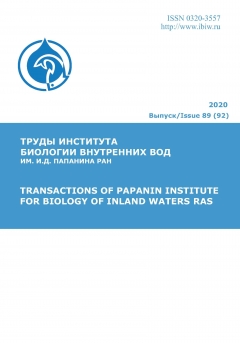The distribution of Myrica gale on the coast of the Gulf of Finland is confined to regularly flooded coastal habitats, characterized by milder environmental conditions compared to the uplands and under the residual influence of the Gulf Stream. In Russia, M. gale is located on the northeastern border of the range. The study of the features of the species that contribute to the dispersal in the northern direction, and the properties of the environment that prevent such dispersal, is always of great interest. Growth in colder conditions in comparison with other members of the family, mainly inhabitants of the tropical and subtropical areas, affected the formation of such adaptations as deciduousness, changes in the structure of flowers and bark, as well as the presence of a large number of protective leaf organs. Their quantitative and qualitative analysis made it possible to establish the presence of 4 lignified parchment-like scales that do not fall completely and 6 membranous with partially lignified tops scales that stretch out while unfolding. An attempt was made for the first time to analyze the spatial structure of the shoots of the species. A sympodial growth of shoots and the phenomenon of acrotonia, as well as a spiral formation of lateral shoots, were established. In the structure of the mature generative branch of M. gale there were identified 3 types of shoots: long growth, medium and short, and also their leaf series were analyzed. Leaf series of short and medium shoots are characterized by significant asymmetry compared to leaf series of long shoots and are incomplete. The curves were constructed on the basis of such characteristics of leaf organs as their total number, length along the central vein, including the petioles (if they are presented), and internode lengths. A large number of rudiments of leaf organs determines the gradual formation of the buds, and the imperfection of the structure of the scales reflects the weak protective ability of these organs. Both features indicate the deep ancientness of the species and the difficulty in adapting to cold environmental conditions. Mature generative branches of M. gale are similar in habit to small trees, which is of particular interest in the context of modeling possible directions of adaptation during the spread of species of subtropical origin to more northern regions.
Myrica gale, morphology of shoots, protective leaf organs, vegetative buds, plant evolution, plant adaptation to the environment
1. Berko I.N., Koziy B.I. O metodike modelirovaniya morfologicheskogo stroeniya monokarpicheskogo pobega travyanistyh mnogoletnikov // V Vsesoyuz. shk. po teoret. morf. rast. L'vov: L'vovskiy gos. un-t., 1987. S. 29-33.
2. Vasilevskaya V. K. Stebel' // Anatomiya rasteniy. M.: Sovetskaya nauka, 1954. 184 s.
3. Krasnaya kniga Rossiyskoy Federacii (rasteniya i griby). Moskva: Tovarischestvo nauchnyh izdaniy KMK, 2008. 855 s.
4. Lapirov A., Belyakov E. Problemy primenimosti koncepcii modul'noy i strukturno-funkcional'noy organizacii cvetkovyh rasteniy k analizu struktury pobegov u nekotoryh grupp sporovyh rasteniy // Zhurnal obschey biologii. 2019. № 80. S. 427-438.
5. Nedoseko O.I., Viktorov V.P. Arhitekturnye tipy kron zhenskih i muzhskih osobey Salix acutifolia L. // Izv. vysshih uchebnyh zavedeniy. Povolzhskiy region. Estestvennye nauki. 2017. № 1 (17). S. 14-27.
6. Savinyh N.P. Primenenie koncepcii modul'noy organizacii k opisaniyu struktury rasteniya // Sovremennye podhody k opisaniyu struktury rasteniy. Kirov: Loban', 2008. S. 47-69.
7. Serebryakov I.G. Morfologiya vegetativnyh organov vysshih rasteniy. M.: Sovetskaya nauka, 1952. 391 s.
8. Serebryakov I.G. Ekologicheskaya morfologiya rasteniy. M.: Vysshaya shkola, 1962. 377 s.
9. Fat'yanova E.V., Antonova I.S. Raznoobrazie pochek u pobegov raznyh morfofunkcional'nyh tipov v krone hurmy kavkazskoy (Diospyros lotus L.) na pozdney generativnoy stadii // Biologicheskie tipy Hristena Raunkiera i sovremennaya botanika: Materialy Vserossiyskoy nauchnoy konferencii “Biomorfologicheskie chteniya k 150-letiyu so dnya rozhdeniya H. Raunkiera”. Kirov, VyatGGU, 2010. S. 392-397.
10. Hohryakov A.P. Zakonomernosti evolyucii rasteniy. Novosibirsk: Nauka, Sib. otd., 1975. 202 s.
11. Hohryakov A.P. Evolyuciya biomorf rasteniy. M.: Nauka, 1981. 168 s.
12. Barthelemy D., Caraglio Y. Plant architecture: A dynamic, multilevel and comprehensive approach to plant form, structure and ontogeny // Ann. Bot. 2007. Vol. 99. P. 375-407.
13. Halle F. Architectural variation at the specific level in tropical trees // Tropical trees as living systems. / Cambridge University Press, Cambridge. 1978. P. 209-222.
14. Kartesz J., Meacham C. Myrica pensylvanica Synthesis of the North American Flora: Nomenclatural innovations, Version 1.0. Chapel Hill, NC. 1999. Vol. 18
15. Maggia L., Bousquet J. Molecular phylogeny of the actinorhizal Hamamelidae and relationships with host promiscuity towards Frankia // Mol. Ecol. 1994. Vol. 3. P. 459-467.
16. Meloche C.G., Diggle P.K. Preformation, architectural complexity, and developmental flexibility in Acomastylis rossii (Rosaceae) //American Journal of Botany. 2001. Vol. 88, №6, P. 980-991.
17. Nitta I., Ohsawa M. Bud and module of evergreen broad-leaved trees in Anaga cloud forests //Anaga cloud forest. A comparative study on evergreen broad-leaved forests and trees of the Canary Islands and Japan. Chiba: Laboratory of Ecology, Chiba University. 1999. P. 139-146.
18. Richards P.W. The Tropical Rain Forest // Cambridge: Cambridge University Press, 1952. 450 p.
19. Robson R., Postgate J. Oxygen and hydrogen in biological nitrogen fixation // Annu. Rev. Microbiol. 1980. Vol. 34. P. 183-207.
20. Shaw B. Oxygen control mechanism in nitrogen-fixing systems // Current developments in biological nitrogen fixation. London: Cambridge University Press, 1984. P. 111-134.
21. Skene K., Sprent J., Raven J., Herdman L. Biological flora of the British Isles: Myrica gale L. // Journal of Ecology. 2000. Vol. 88. P. 1079-1094.
22. Sprent J., Scott R. The nitrogen economy of Myrica gale and its possible significance for the afforestation of peat soils // Symbiotic nitrogen fixation in the management of temperate forests. Cowallis: Forest Research Laboratory, Oregon State University. 1979. P. 234-242.
23. St-Laurent L., Lalonde M. Isolation and characterization of Frankia strains isolated from Myrica gale // Can. J. Bot. 1987. Vol. 65. P. 1356-1363.
24. Tjepkema J. Oxygen concentration within the nitrogen-fixing root nodules of Myrica gale L. // Am. J. Bot. 1983. Vol. 70. P. 59-63.
25. Tjepkema J. The role of oxygen diffusion from the shoots and nodule roots in nitrogen fixation by root nodules of Myrica gale // Can. J. Bot. 1978. Vol. 56. P. 1365-1371.
26. Torrey J., Callaham D. Determinate development of nodule roots in actinomycete-induced root nodules of Myrica gale // Can. J. Bot. 1978. Vol. 56. P. 1357-1364.
27. Vandenbosch K., Torrey J. The development of endophytic sporangia in field and laboratory-grown nodules of Comptonia peregrina and Myrica gale // Am. J. Bot. 1985. Vol. 72. P. 99-108.








